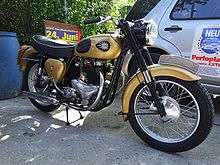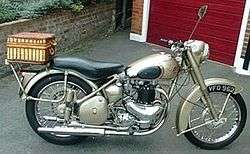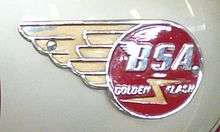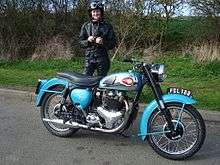BSA Golden Flash
 | |
| Manufacturer | Birmingham Small Arms Company (BSA) |
|---|---|
| Also called | A10 |
| Production | 1950–61 |
| Predecessor | none |
| Successor | BSA A65 |
| Engine | 646 cc (39.4 cu in) air cooled twin |
| Power | 35 bhp (26 kW) @ 4500 rpm |
| Transmission | four-speed gearbox to chain drive |
| Wheelbase | 54.75 in (1,391 mm) |
| Dimensions |
L: 84 in (2,100 mm) |
| Weight |
375 lb (170 kg) (dry) |
| Fuel capacity | 3.5 imp gal (16 L) |
The BSA Golden Flash was a 646 cc (39.4 cu in) air-cooled parallel twin motorcycle designed by Bert Hopwood and produced by Birmingham Small Arms Company at Small Heath, Birmingham. Code-named the BSA A10, it was available in black and chrome; but it was the distinctive golden paint scheme that gave The Golden Flash its name.
Development
Background and development
Bert Hopwood served an apprenticeship under designer Val Page at Ariel. In 1936, Hopwood moved to Triumph, where he worked under Edward Turner to develop the 1937 Triumph Speed Twin. The innovative Speed Twin became the exemplar of the parallel twin engine layout for British motorcycles in the 1950s and 1960s. In April 1947 Hopwood joined Norton to design the Norton Dominator engine.
BSA, then the largest UK motorcycle manufacturer, was falling behind in the parallel-twin race. Although BSA had a parallel-twin, the BSA A7, they needed to develop the bike to remain competitive. In May 1948, the factory enticed Hopwood after only a year at Norton,[1] and he was commissioned to create a competitive BSA parallel-twin.[2] Launched in October 1949, Hopwood's A10 Golden Flash drew heavily from the A7 design by Page and Bert Perkins.[3]

The A10 was increased to 650 cc (40 cu in), with a revised alloy rocker box and cast-iron cylinder head, plus an integral manifold for the single Amal carburettor. A semi-unit gearbox meant the primary chain was adjustable via a slipper tensioner within the primary chain case. The frame was available in rear rigid format, but the more common option was plunger suspension, adopted for the export market.[4] The A10 featured a hinged rear mudguard to ease rear wheel removal. The A10 was so closely based on the A7 that it used many of its well-proven components, and this large carry-over of parts from the A7 promised greater reliability, with minimal risk of new technical problems.[3]

Production
The BSA Golden Flash was launched in a new gold colour, and 80% of production was destined for the United States. This resulted in long delivery times for British customers, who were offered the model only in black.[5]
Although never designed as a sport motorcycle, the Golden Flash was nonetheless fast for its time and competitive with the Triumph Tiger 100, achieving over 100 miles per hour (160 km/h) in tests in 1950, and covering a standing quarter mile (400 m) in under 16 seconds.[6] Its gold colour proved a marketing success, outselling Triumph's Speed Twin and 6T Thunderbird.
BSA were concerned about that wear in the plunger suspension was leading to uncertain handling. In 1954 the factory adopted a swinging arm,[7] and the hinged mudguard was deleted. In seemingly backwards step, the semi-unit gearbox was abandoned for a separate "pre-unit" item. The new design had a different primary chain adjustment, a modified clutch, and new gearbox internals.

A more sporting model was launched in 1954: the A10 Road Rocket with twin carburettors and an alloy cylinder head. In 1956, alloy brake drums were fitted as standard to reduced unsprung weight and improve braking performance.

In 1957, the 40 bhp (30 kW) 105 miles per hour (169 km/h) BSA Super Rocket was launched for the 1958 season, with an Amal TT carburettor and high lift cam.
The final A10 development in terms of power and performance was the 1962 BSA Rocket Gold Star. A tuned A10 Super Rocket engine was installed into the well-proven BSA Gold Star single frame. The result was a fast bike that handled well, and which became a collectable "classic". Demand for the Rocket Gold Star, or "RGS", is such that non-original "RGS A10"s are sometimes upgraded to RGS specifications.[3]
In the late 1950s, motorcycle electrical component manufacturer Lucas decided to switch production from magneto/dynamo systems to alternators/coil systems. This forced British motorcycle manufacturers to completely redesign their engines. With the launch of the new unit construction (combined engine/gearbox) BSA A50 and BSA A65, the A7 and A10 were discontinued at the end of 1962 but the Rocket Gold Star continued into 1963 production.
Further reading
- Bacon, Roy (1980). BSA Twins & Triples The postwar A7/A10, A50/65 and Rocket III. Oxford: Osprey Publishing.
See also
References
- ↑ "Norton Dominator" (PDF). Archived from the original (PDF) on July 28, 2011. Retrieved 2008-12-20.
- ↑ "The BSA Owners' Club Library archives". Retrieved 2008-12-20.
- 1 2 3 Kemp, Andrew (2001). Classic British Bikes. Bookmart Ltd. pp. 120–121. ISBN 1-86147-058-4.
- ↑ "Lot 031: 1950 BSA A10 Golden Flash". Motorbase. Retrieved 2008-05-13.
- ↑ "BSA Golden Flash on test". Classic Bike Guide. May 2008.
- ↑ Real Classic BSA A10 (accessed 2008-05-13)
- ↑ Brown, Roland (2002). Classic Motorcycles. Anness Publishing. pp. 120–123. ISBN 1-84038-433-6.
External links
| Wikimedia Commons has media related to BSA A10 Golden Flash. |